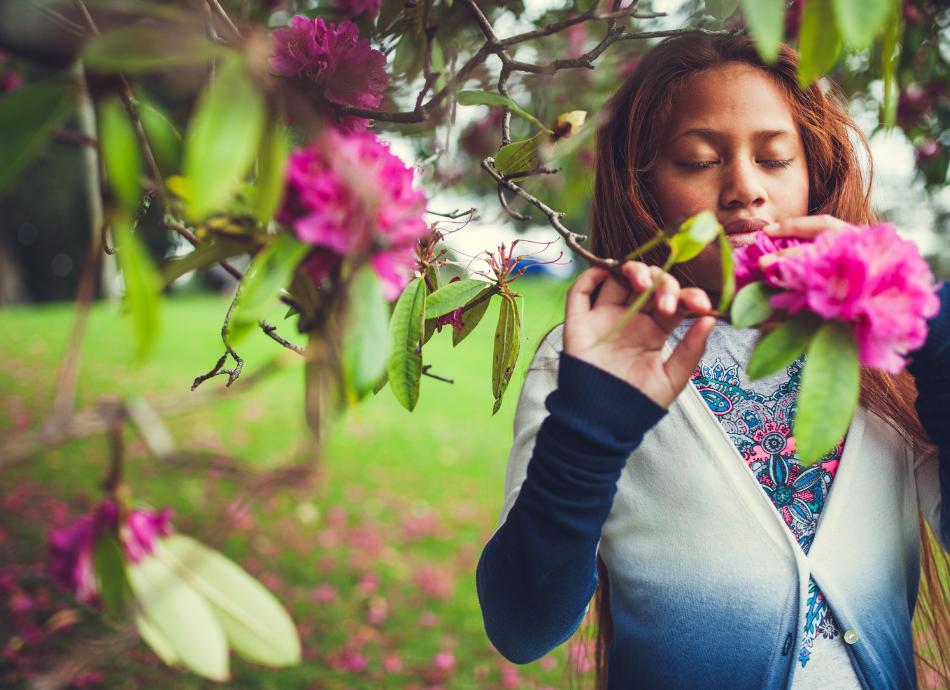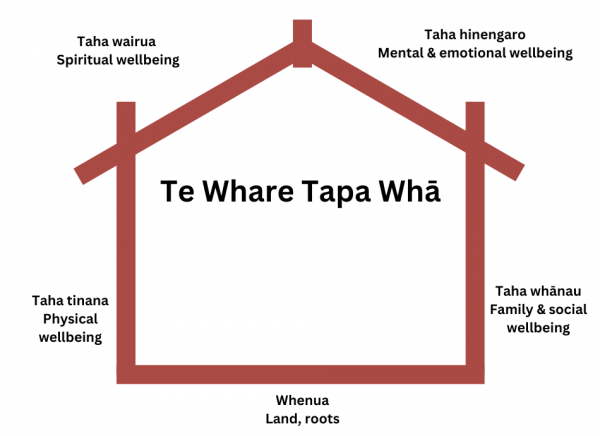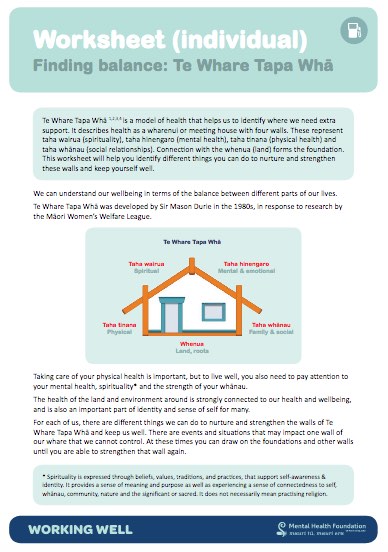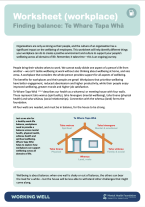Wishing everyone a safe and happy Christmas and New Year – Meri Kirihimete from the Healthify team.
Te whare tapa whā and wellbeing
Key points about te whare tapa whā and wellbeing
- Developed by Sir Mason Durie in 1984, Te Whare Tapa Whā is a Māori model of health and wellbeing.
- It's a metaphor based on 4 pillars of a wharenui/meeting house. When we look after all 4 aspects, we look after our hauora/wellbeing.
- Checking in on the 4 pillars helps us balance our hauora and support others to balance theirs too.
- The main content on this page comes from the Mental Health Foundation of New Zealand(external link).

Te Whare Tapa Whā was developed by leading Māori health advocate Sir Mason Durie in 1984. The model describes health and wellbeing as a wharenui/meeting house with 4 walls. When we look after all 4 aspects, we look after our hauora/wellbeing. Checking in on the 4 pillars helps us balance our hauora and support others to balance theirs, too.
These walls represent:
- taha wairua – spiritual wellbeing
- taha hinengaro – mental and emotional wellbeing
- taha tinana – physical wellbeing
- taha whānau – family and social wellbeing.
Our connection with the whenua/land forms the foundation.
When all these things are in balance, we thrive. When one or more of these is out of balance our wellbeing is impacted.

Image credit: Healthify He Puna Waiora
By nurturing and strengthening all 5 dimensions, you support your health and wellbeing, as well as the health and wellbeing of your whānau.
Below are some examples for supporting you and your whānau. You may have others that work for you.
Video: Billie Pomana – hot pool healing
(Healthify He Puna Waiora and Health New Zealand | Te Whatu Ora Waitematā, NZ, 2022)
Taha wairua explores your relationship with the environment, people and heritage in the past, present and future.
The way people view wairua can be very different. For some, wairua is the capacity for faith or religious beliefs or having a belief in a higher power. Others may describe wairua as an internal connection to the universe. There is no right or wrong way to think of or experience wairua, but it is an important part of our mental wellbeing.
Find ways to keep your spirits high. Listen to uplifting waiata/music, attend online karakia sessions, soak up the rays of the sun or listen to native manu/birds like tui or ruru.
Just like your physical health, your taha hinengaro/mental and emotional wellbeing needs to be taken care of. Taha hinengaro is your mind, heart, conscience, thoughts and feelings. It’s about how you feel, as well as how you communicate and think.
Keep your mind active with things like learning karakia/prayer, waiata/music or mau rākau/Māori weaponry. Try reading some pūrākau/stories or whakapapa about your ancestors or the days of old. Tune in to some of the online wānanga/workshops available such as learning te reo Māori.
Taha tinana is about how your body feels and how you care for it. Refuelling your body helps you to feel mentally well. Sometimes your tinana might not be where you’d like it to be and this might be beyond your control. What’s important is that you do what you can to nurture it.
Staying physically well is important. Try walking or practising mau taiaha/Māori weaponry or even kapa haka.
Taha whānau is about who makes you feel you belong, who you care about and who you share your life with.
Whānau is about extended relationships – not just immediate relatives. It’s your hoamahi/colleagues, friends, community and the people you care about. You have a unique place and a role to full within your whānau and your whānau contributes to your wellbeing and identity.
Keeping in touch is so important. Send aroha from afar by holding regular online or phone catch ups with your whānau and kaumatua. Connect more with whānau and friends kanohi ki te kanohi/face-to-face.
Whenua is the place where you stand. It is your connection to the land – a source of life, nourishment and wellbeing for everyone. Whenua includes soil, rocks, plants, animals and people – the tangata whenua. We are linked physically and spiritually to the land – it is the earth through which you are connected to your tūpuna/ancestors and all the generations that will come after you.
You can also think about whenua as your place of belonging – that means the spaces where you feel comfortable, safe and able to be yourself. It could be around your friends, at home with whānau, as part of a sports team or even at your place of study or mahi/work.
Video: He kai kei aku ringa | Jasmine Gray
Jasmine Gray is a midwife and a mother to 5 children. She sees health as a holistic endeavour that is connected to all the ways in which we are in a relationship with the natural world, with our communities and with our bodies.
(Toi Tangata, NZ, 2021)
Video: He kai kei aku ringa | Tiana Ngawati
Tiana and her husband, Brad, are parents to a beautiful daughter. They are also both dedicated athletes with an in-depth awareness of how good nutrition can enhance their athletic performance.
(Toi Tangata, NZ, 2021)
Video: He kai kei aku ringa | Te Ara Hou Huia
Te Ara Hou is a mother of 3, and a new student at Toihoukura, a Māori visual arts school. He kai kei aku ringa for her is a calling of encouragement, a calling for her to keep reaching out for more, to fill her hands with the skills needed to collect the kai that’s available at hand.
(Toi Tangata, NZ, 2021)
Video: He kai kei aku ringa | Alex Hawea
Alex has lived in the West Auckland community for the past 20 years. Living in such a demanding urban centre means Alex is constantly walking a fine line between meeting the material and cultural needs of his whānau.
(Toi Tangata, NZ, 2021)
Video: He kai kei aku ringa | Ebony Ranapia
Ebony has been planting and harvesting kumara in the small town of Te Teko her whole life. The practice from start to finish has been passed down through her whānau for generations, as have many other life lessons.
(Toi Tangata, NZ, 2021)
Ignite(external link) NZ Online NZ support to strengthen wellbeing
Identity and culture activities for children(external link) Sparklers, NZ
Brochures
Te Whare Tapa Whā translated(external link) Asian Family Services, NZ Chinese(external link), Korean(external link), Japanese(external link), Vietnamese(external link), Thai(external link), Hindi(external link)
Finding balance – Te Whare Tapa Whā (for individuals)(external link) Mental Health Foundation, NZ
Finding balance – Te Whare Tapa Whā (workplace)(external link) Mental Health Foundation, NZ
Podcast
Five ways to wellbeing(external link) (podcast) What Works Centre for Wellbeing, UK, 2023
Executive Director Nancy Hey joins the Sketchplanations podcast to talk through five simple, evidence-informed ways to improve mental wellbeing.
References
- Te Whare Tapa Whā(external link) Mental Health Foundation, NZ
- Te Whare Tapa Whā – getting through together(external link) Mental Health Foundation, NZ
- Te whare tapa whā resource(external link) Health Quality & Safety Commission, NZ
Who created te whare tapa whā?
The te whare tapa whā model of health was created by Sir Mason Durie in 1984. Now retired, he was a psychiatrist and academic who focused on Māori health and education, believing in a holistic approach to well-being that encompasses mind, spirit, body, and family.
What does te whare tapa whā mean?
Te whare tapa whā represents a meeting house (wharenui) of 4 walls. The walls represent the 4 aspects of hauora (well-being) – taha wairua (spiritual wellbeing), taha hinengaro (mental and emotional wellbeing), taha tinana (physical wellbeing) and taha whānau (family and social wellbeing).
What is te whare tapa whā?
Te whare tapa whā is a holistic Māori model of health which describes hauora (health and wellbeing) as a wharenui (meeting house) where the 4 walls represent different aspects of health. Our connection to the land (whenua) provides the foundation to the wharenui. The 4 walls are taha wairua (spiritual wellbeing), taha hinengaro (mental and emotional wellbeing), taha tinana (physical wellbeing) and taha whānau (family and social wellbeing).
We need these different dimensions to be in balance for strength and stability. By nurturing and strengthening each of these areas, we can support our holistic health and wellbeing. If 1 or more of these walls are out of balance, it affects our hauora.
Brochures

Mental Health Foundation, NZ

Mental Health Foundation, NZ
Credits: Mental Health Foundation of New Zealand
Reviewed by: Healthify editorial team. Healthify is brought to you by Health Navigator Charitable Trust.
Page last updated:





